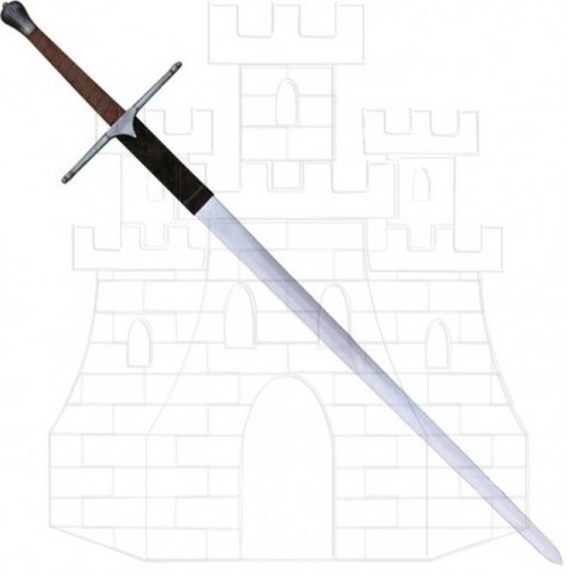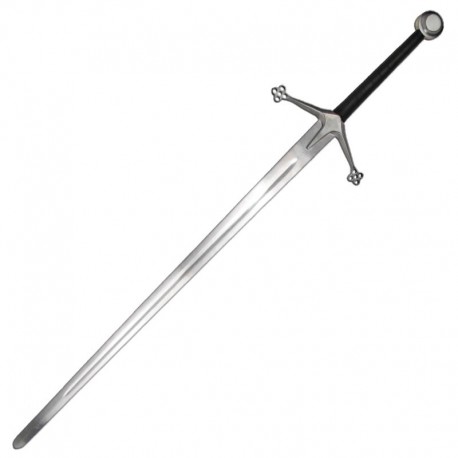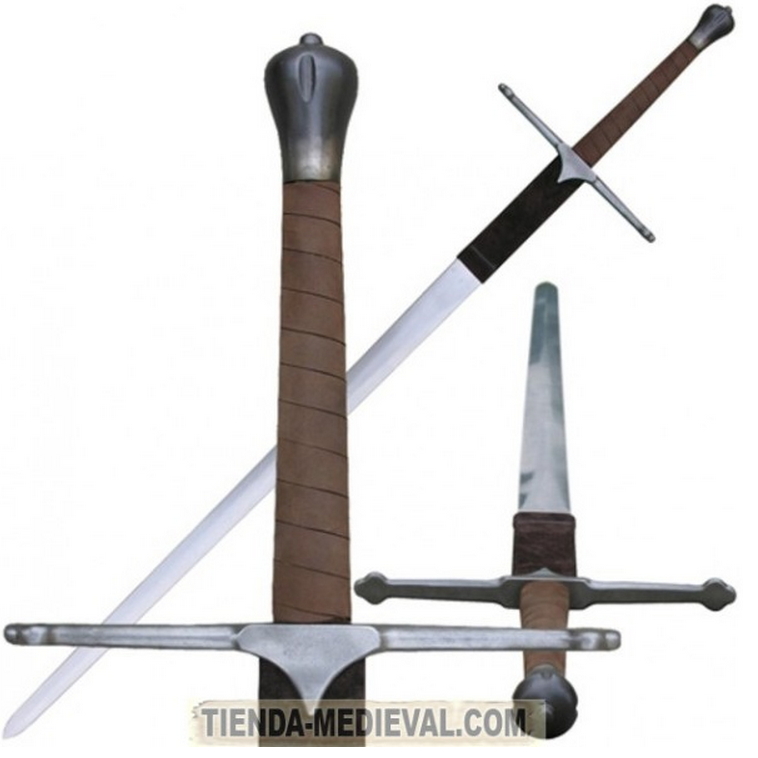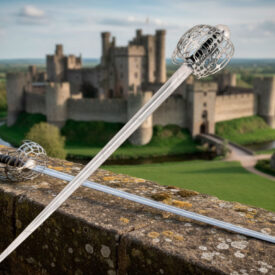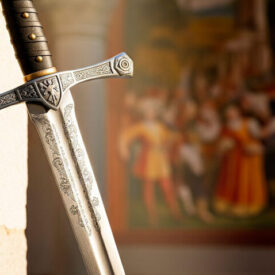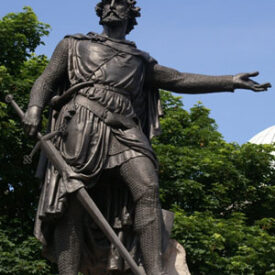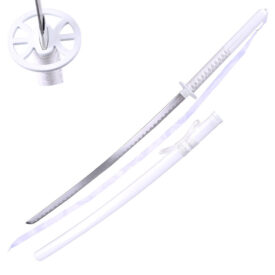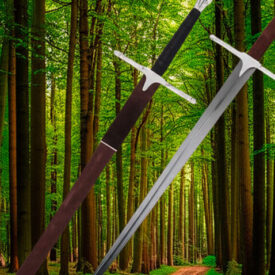What is a Claymore sword and why it fascinates
The Claymore sword is an emblematic great Scottish sword that requires the use of both hands to be wielded. It is also known as an upward sword, greatsword, or two-handed sword. More than a museum piece, the Claymore represents a combination of strength, technique, and military culture that endures in the collective imagination.
Why is it still so interesting today? Because it combines history, functional design, and visual presence. For anyone looking to understand historical weapons or choose a functional replica, the Claymore offers lessons on ergonomics, two-handed combat, and weapon evolution.
Origin and history: the Claymore through time
The Claymore strongly emerges in the 13th-15th centuries in Scotland, where clan warriors wielded it in their struggle against invasions and in internal conflicts. During that period, the great sword ceased to be an exclusive cavalry weapon to become a lethal tool for foot soldiers: it was used in formations, in duels, and in low to medium-range hostilities.
The first historical Claymores were long swords, often over 120 cm, with robust blades and guards that protected the hand. Their presence in chronicles and Scottish folklore cemented their legend. Over time, the form became standardized but maintained regional variations: some examples were heavier, others more balanced for greater speed.
Claymore and battle: main functions
- Cutting with power: the length and mass allowed for devastating cuts that could penetrate light armor and damage exposed bones.
- Opponent control: the guard with advanced arms formed a quillon that allowed stopping or hooking the opponent’s weapons.
- Versatility in formation: although it was a foot soldier’s weapon, its reach offered an advantage against enemies with short spears or hand weapons.
Design and distinctive elements of the Claymore
The Claymore is characterized by a special guard: a forward ricasso on the blade, with two symmetrical arms topped with ornamental volutes that converge in a triangular apex. This design creates a powerful quillon that, in skilled hands, allows for defensive actions such as stopping, deflecting, or even hooking the opposing weapon. In addition to its aesthetics, the guard fulfills a practical function in two-handed combat.
Key parts
- Blade: straight and long, designed for cuts and occasional thrusts.
- Guard: with a triangular quillon and crossed arms that protect the hand and serve for defensive maneuvers.
- Handle: designed for two-handed grip, often with a robust pommel to balance the sword.
- Pommel: counterbalance that aids in balance and allows for changes of pace in handling.
Sizes and weights: what to expect
In medieval times, many Claymores exceeded 1.20 meters in length and weighed more than 1.5 kg. However, there were variations: some exceeded 1.8 m in total length, if the long handle and extended blade were counted. The weight and length determined the combat style: longer swords offered greater reach at the expense of speed; shorter ones favored maneuverability.
Quick comparison: lengths and use
| Type | Average length | Typical weight | Main use |
|---|---|---|---|
| Classic Claymore | 1.20 m – 1.50 m | 1.5 kg – 2.5 kg | Open field combat, powerful cuts |
| Long variants | 1.50 m – 1.80 m | 2 kg – 3.5 kg | Extended reach, formations |
| Compact models | 1.00 m – 1.20 m | 1 kg – 1.8 kg | Increased maneuverability, training |
The Claymore vs. other great swords
It is common to confuse the Claymore with other large European swords. Here we clarify key differences:
- Claymore vs. continental two-handed sword: both are large swords, but the Scottish Claymore stands out for its specific hilt and its cultural use in Scotland. The continental two-handed sword features more subdued hilts and blades with different geometries.
- Claymore vs. bastard sword: the bastard sword can be used with one or two hands; the Claymore is mainly designed for two-handed grip and for the action of the quillon.
William Wallace and the legend: clarifying misunderstandings
There is a popular idea that William Wallace, the Scottish hero, wielded a Claymore exactly like the typical historical swords. However, we should not confuse museum swords with the actual weapon attributed to Wallace. Iconography and cinema have shaped an imposing image, but historical sources do not allow us to state with certainty that his sword had all the characteristics of standardized Claymores.
The confusion arises because many commercial replicas are labeled as “William Wallace’s sword” to attract interest, even if they are stylized versions. Knowing how to distinguish between a thematic replica and a historically accurate replica is essential for collectors and practitioners.
Functional vs. decorative replica: what to choose
When buying a Claymore today, there are two main categories:
- Decorative: intended for display. Often lighter, with less resistant materials and a blade not suitable for actual use.
- Functional: forged for cutting and training. High-quality steel construction, tempered and treated to withstand impact.
Comparative table: decorative vs. functional
| Characteristic | Decorative | Functional |
|---|---|---|
| Material | Economic stainless steel or light alloys | Carbon steel or tempered carbon steel (1060-1095, 5160, etc.) |
| Size | Adjusted to aesthetics, sometimes smaller | Historically consistent dimensions |
| Balance | Little attention to balance | Balanced for handling and cuts |
| Price | Moderate to low | Medium to high depending on quality |
Basic techniques and safety for handling a Claymore
The Claymore demands technique and respect. It is not an exhibition item for unsupervised beginners. Here are some practical guidelines:
- Train with an instructor: posture, movements, and the use of both hands require guidance.
- Start with practice replicas: wooden or mild steel versions reduce risks during learning.
- Use protective equipment: helmet, torso protection, and gloves are essential in sparring.
- Maintenance: clean and oil the blade, check the grip and rivets before each use.
Manufacturing and materials: how they influence performance
The quality of a Claymore depends on the steel, heat treatment, and craftsmanship. Carbon steel with proper tempering and annealing offers elasticity and strength. Poor tempering can lead to fractures or a blade that bends easily.
Tips for evaluating a functional replica
- Test the balance: the sword should pivot naturally near the guard.
- Check the finish: well-made welds and joins are a sign of care.
- Consult materials: look for indications of steel type and heat treatment.
Emblematic models and current examples
In the current market, there are classic replicas that imitate the historical style and others that recreate popular aesthetics (such as the “William Wallace sword”). Functional replicas are distinguished by weight, length, and forging quality.
Comparative table of popular models
| Model | Total length | Weight | Type | Recommended for |
|---|---|---|---|---|
| Historical functional Claymore | 125 cm | 1.8 kg | Functional | Training and cutting |
| Long display Claymore | 150 cm | 2.6 kg | Decorative | Collectors and decoration |
| Thematic replicas (Wallace) | 120 cm | 2.0 kg | Varies | Fans and medieval events |
Care, storage, and preservation
To keep a Claymore in good condition, follow simple guidelines: avoid humidity, clean the blade after use, oil it with light oil, and check the hilt. In the case of antique replicas or historical pieces, storage in controlled environments and the intervention of a professional restorer are recommended.
Legal aspects and transport
Laws regarding bladed weapons vary. Before purchasing or transporting a Claymore, inform yourself about local regulations. Although many replicas are legal as collector’s items, their public transport or exhibition at events may require permits or safety measures.
Quick guide to buying your Claymore
- Define use: decoration, training, or HEMA/historical combat.
- Budget: functional quality usually comes at a higher cost.
- Review technical specifications: steel type, length, weight, balance, and heat treatment.
- Manufacturer’s warranty and reputation: better guarantees usually indicate higher quality.
Why choose a Claymore today?
The Claymore is not just a historical piece; it is an object that connects tradition and technique. For reenactors, HEMA practitioners, and collectors, it offers lessons on two-handed handling, combat strategies, and historical aesthetics. Its design combines beauty and function.
Ideas to integrate a Claymore into your project
- Thematic decoration in spaces dedicated to military history.
- Use in audiovisual productions for visual authenticity.
- HEMA training and controlled cuts with a qualified instructor.
Final summary and call to action
The Claymore sword represents a key piece of historical Scottish warfare equipment: specialized design, combat impact, and an iconic presence that continues to attract collectors and practitioners. If you are looking for a replica, first decide on the use and quality you need: a good functional Claymore requires investment, maintenance, and respect for technique.
VIEW MORE CLAYMORE SWORDS | VIEW WILLIAM WALLACE SWORDS | VIEW SCOTTISH SWORDS

